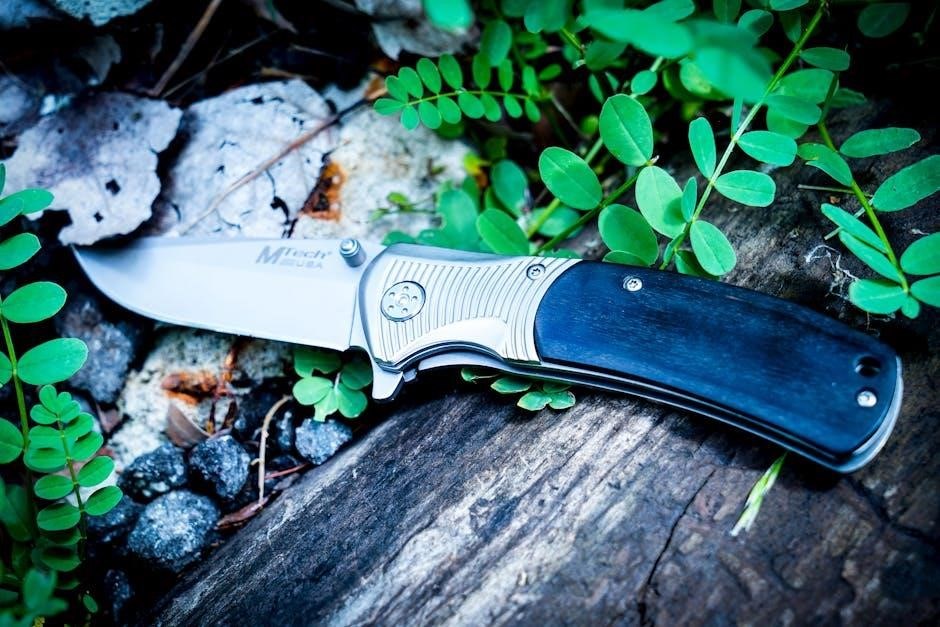knife steel chart pdf
A knife steel chart is a vital tool for understanding blade performance, comparing steel types, and making informed decisions. It simplifies complex metallurgy into clear ratings and categories, helping users prioritize properties like hardness, toughness, and corrosion resistance. Whether you’re a professional knife-maker or an enthusiast, these charts provide a straightforward way to evaluate steel alloys and select the best option for your needs. They are particularly useful for identifying steel suited for specific applications, such as kitchen knives, tactical blades, or everyday carry tools. By breaking down steel properties into visual and numerical comparisons, knife steel charts empower users to make educated choices without deep metallurgical expertise.
Understanding the Importance of Knife Steel
Knife steel is the backbone of a blade’s performance, directly influencing its durability, sharpness, and versatility. The composition of steel determines properties like hardness, toughness, and corrosion resistance, which are critical for specific tasks. For instance, high-carbon steels excel in edge retention, while stainless steels prioritize rust resistance. Understanding these factors helps users choose the right steel for their needs, whether for culinary precision, outdoor durability, or everyday reliability. A knife steel chart simplifies this process, providing a visual guide to compare alloys and their attributes. This knowledge empowers both makers and users to select the optimal steel for their tools, ensuring peak performance and longevity. It bridges the gap between complex metallurgy and practical application, making informed decisions accessible to all.
What is a Knife Steel Chart?
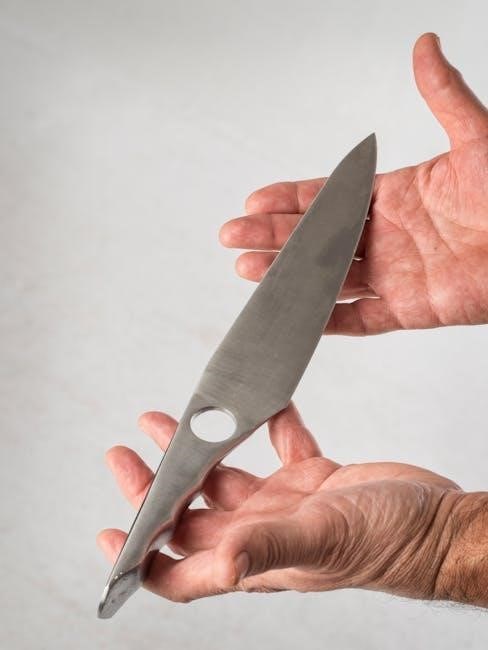
A knife steel chart is a comprehensive guide that categorizes and compares various steel alloys used in knife-making. It provides detailed ratings and properties of each steel type, such as hardness, toughness, edge retention, and corrosion resistance. These charts act as a quick reference for knifemakers and enthusiasts, helping them evaluate and select the best steel for specific applications. By presenting complex metallurgical data in a simplified format, the chart enables users to understand the strengths and weaknesses of different steels. Whether for kitchen knives, tactical blades, or everyday carry tools, the chart serves as an essential tool for making informed decisions and achieving optimal blade performance.
Purpose of a Knife Steel Chart
The primary purpose of a knife steel chart is to simplify the process of selecting the ideal steel for specific knife-making needs. By organizing and comparing steel alloys based on key properties like hardness, toughness, corrosion resistance, and edge retention, the chart helps users make informed decisions. It serves as a quick reference guide for both professionals and enthusiasts, allowing them to identify the best steel for applications ranging from kitchen knives to tactical blades. The chart also helps in understanding trade-offs between properties, ensuring the chosen steel aligns with the intended use of the knife. This tool is invaluable for balancing performance, durability, and maintenance requirements in blade creation.
Factors Affecting Knife Steel Performance
The performance of knife steel is influenced by hardness, toughness, corrosion resistance, and edge retention. These factors determine how well a blade holds its edge and endures use.
Hardness and Its Impact on Edge Retention
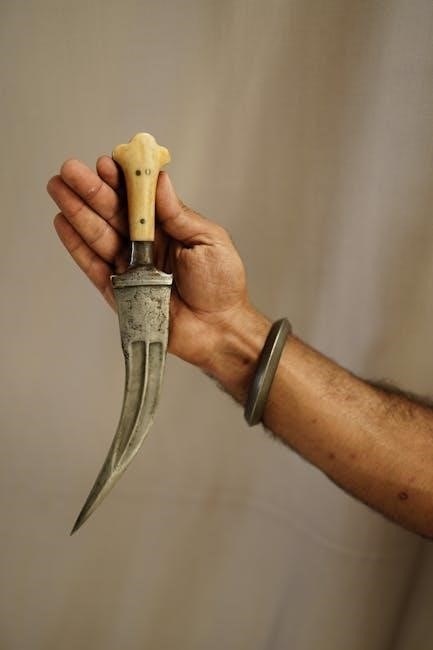
Hardness is a critical factor in determining a knife’s edge retention, as it measures a steel’s resistance to deformation. Higher hardness levels typically result in better edge retention, as the blade resists wear and maintains sharpness longer. However, excessive hardness can compromise toughness, making the knife more prone to chipping or breaking under stress. Steel hardness is often measured on the Rockwell Hardness Scale (HRC), with common knife steels ranging from 54 to 66 HRC. A balance between hardness and toughness is essential, as overly hard steels may lack durability, while softer steels may dull quickly. This trade-off is a key consideration in selecting steel for specific applications.
Toughness and Durability in Knives
Toughness refers to a knife steel’s ability to absorb impact without breaking or deforming, ensuring durability in demanding conditions. High toughness means the blade can withstand heavy use, drops, and lateral stress without cracking. This property is crucial for knives used in survival, tactical, or outdoor applications. While hardness contributes to edge retention, toughness ensures the knife remains functional under stress. Steels like D2 and S30V are known for their balance of hardness and toughness, offering both edge retention and resistance to damage. Achieving optimal toughness often requires careful heat treatment and alloy composition, as excessive hardness can compromise this critical property. Balancing toughness with other traits is essential for a reliable knife.
Corrosion Resistance and Stainless Steels
Corrosion resistance is a critical factor in knife steel, especially for blades exposed to moisture, humidity, or harsh environments. Stainless steels, such as 420HC or 154CM, are engineered to resist rust and corrosion due to their high chromium content, which forms a protective oxide layer on the surface. This property makes them ideal for knives used in marine, culinary, or outdoor settings. While stainless steels may sacrifice some hardness and edge retention compared to high-carbon steels, their durability in corrosive conditions makes them a practical choice. The knife steel chart highlights these trade-offs, helping users prioritize corrosion resistance based on their specific needs and applications.
Edge Retention and Sharpening Ease
Edge retention and sharpening ease are pivotal in evaluating knife steel performance. Steels with high hardness, like S30V or M390, excel in retaining sharpness but can be challenging to sharpen due to their dense microstructure. Conversely, softer steels, such as 420HC or 8Cr13MoV, sacrifice some edge retention for easier sharpening, making them more user-friendly. The knife steel chart illustrates this balance, helping users identify steels that align with their maintenance preferences. For instance, high-carbon steels offer superior edge retention but require more skill to sharpen, while stainless steels may be less durable but are more forgiving for everyday use. This trade-off is essential for selecting the right steel for specific tasks.
Detailed Breakdown of the Knife Steel Chart
The chart provides a detailed comparison of knife steels, evaluating hardness, toughness, corrosion resistance, and edge retention, visually guiding users in selecting the best steel for their specific needs.
How to Read a Knife Steel Chart
Reading a knife steel chart involves understanding its visual representation of steel properties. Typically, the chart compares different steels based on hardness, toughness, corrosion resistance, and edge retention. Each steel type is plotted on a graph, with axes representing key properties. For example, hardness might be on the x-axis, while toughness is on the y-axis. Colors or symbols differentiate steel types, and a legend explains these differences. Users can quickly identify steels that balance desired traits. The chart also highlights trade-offs, such as high hardness often sacrificing toughness. This tool helps knife enthusiasts and makers select the best steel for their specific needs, whether for culinary, outdoor, or everyday use.
Common Knife Steels Compared
A knife steel chart provides a side-by-side comparison of popular steels, such as 420HC, S30V, 1095, and D2. These steels are evaluated based on hardness, toughness, corrosion resistance, and edge retention. Stainless steels like 420HC and S30V excel in corrosion resistance, making them ideal for marine or culinary use. High-carbon steels like 1095 and D2 offer superior hardness and edge retention but may lack in corrosion resistance. Specialty steels, such as M390 or Damascus, combine unique aesthetics with exceptional performance. The chart simplifies these comparisons, helping users identify the best steel for their intended application. This visualization enables quick decision-making for knife enthusiasts and makers.
Visual Representation of Steel Properties
A knife steel chart PDF often includes visual representations, such as color-coded matrices or bar graphs, to illustrate the properties of different steels. These visuals simplify complex data, making it easier to compare hardness, toughness, corrosion resistance, and edge retention. For instance, a radar chart might display a steel’s balance of properties, while a heatmap could highlight optimal choices for specific tasks. Icons or symbols may also denote attributes like wear resistance or ease of sharpening. These visual tools reduce complexity, allowing users to quickly identify the best steel for their needs. This approach ensures that even non-experts can make informed decisions based on clear, intuitive representations.
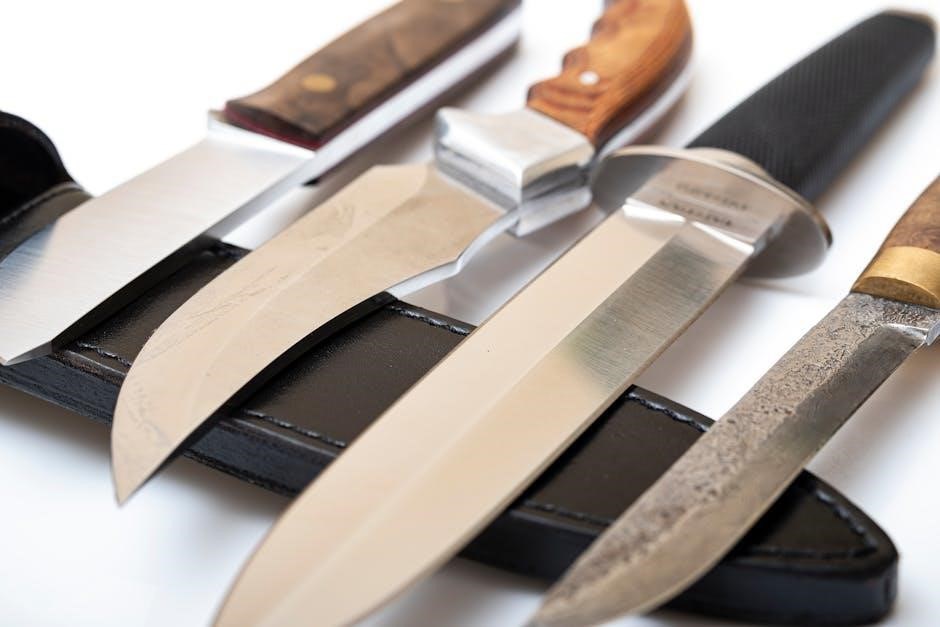
Types of Steel for Knives
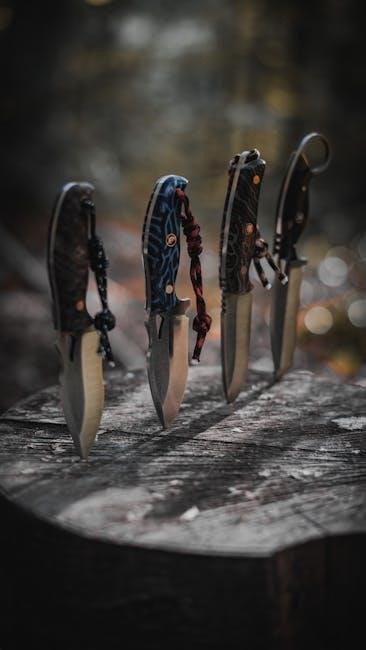
Knife steels are categorized into stainless, high-carbon, and specialty types. Stainless steels offer corrosion resistance, high-carbon steels provide hardness and edge retention, and specialty steels like Damascus and titanium offer unique aesthetic or functional properties for various knife applications.
Stainless Steel Alloys
Stainless steel alloys are renowned for their exceptional corrosion resistance, making them ideal for knives exposed to moisture or harsh environments. These steels typically contain a minimum of 10.5% chromium, which forms a protective oxide layer. Common additions like nickel, molybdenum, or nitrogen enhance durability and resistance to wear. While they may lack the edge retention of high-carbon steels, their ability to resist rust makes them practical for everyday use. Popular stainless steel alloys include 420HC, 440C, and 154CM, each offering a balance of strength, corrosion resistance, and sharpening ease. They are widely used in kitchen, EDC, and tactical knives, providing reliability and low maintenance.
High-Carbon Steels
High-carbon steels, containing between 0.5% to 1.5% carbon, are prized for their hardness and edge retention, making them ideal for knives requiring sharpness and durability. These steels are harder than stainless steels, offering superior wear resistance but less flexibility. Common examples include 1095, 1084, and 15N20, often used in high-performance knives. While they excel in cutting applications, their higher carbon content makes them more susceptible to corrosion, necessitating proper maintenance. This trade-off of hardness for corrosion resistance makes high-carbon steels a popular choice among knife enthusiasts seeking optimal cutting performance.

Specialty Steels (e.g., Damascus, Titanium)
Specialty steels like Damascus and Titanium offer unique properties that set them apart from traditional knife steels. Damascus steel, known for its distinctive wavy patterns, is crafted through a labor-intensive process of forge-welding and folding steel, resulting in both aesthetic appeal and exceptional strength. Titanium, on the other hand, is lightweight, corrosion-resistant, and hypoallergenic, making it ideal for knives used in marine or medical environments. These steels are often chosen for their rarity, visual appeal, or specific functional advantages. While they may not always outperform high-carbon or stainless steels in hardness or edge retention, they are highly valued for their unique characteristics and versatility.
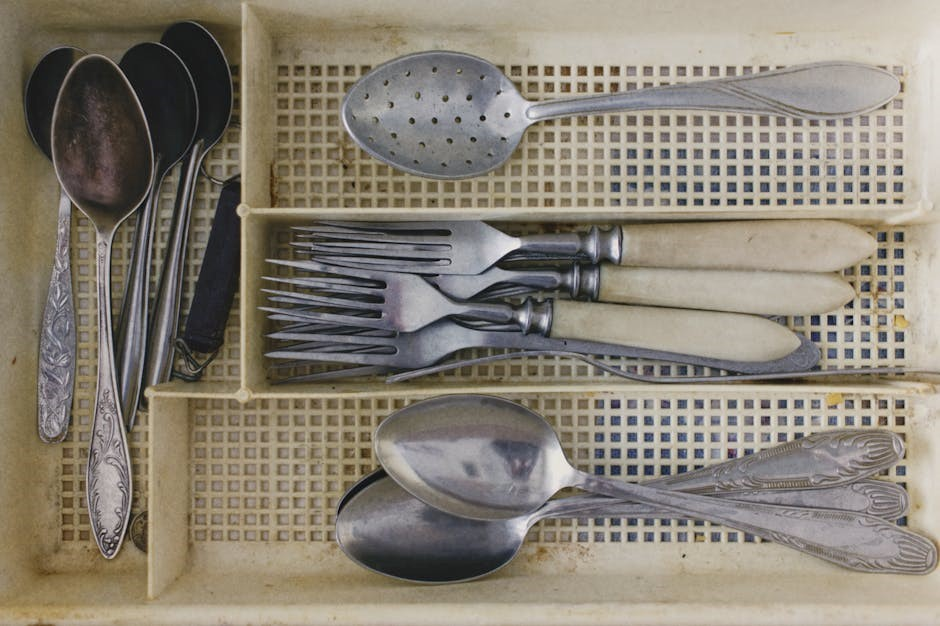
Applications of the Knife Steel Chart
The chart aids in selecting steel based on hardness, corrosion resistance, and edge retention, helping knife makers and enthusiasts choose the best material for their needs.
Choosing Steel for Kitchen Knives
When selecting steel for kitchen knives, prioritize sharpness, edge retention, and ease of sharpening. High-carbon steels like 1095 and 15N20 are ideal for culinary use due to their excellent edge retention and durability. Stainless steels such as 420HC and 154CM are also popular, offering rust resistance while maintaining sharpness. For professional chefs, D2 or A2 steels are recommended for their superior hardness and wear resistance. However, they may require more maintenance. A knife steel chart helps compare these properties, ensuring the chosen steel aligns with the knife’s intended use and the user’s skill level. This guide simplifies the decision-making process for both enthusiasts and professionals.
Steel Selection for Tactical and Survival Knives
For tactical and survival knives, steel selection is critical due to the demanding conditions they endure. High-carbon steels like D2 and S30V are popular choices, offering exceptional hardness, edge retention, and resistance to wear. These steels are less likely to chip or break under stress. For added corrosion resistance, coatings or stainless steel options like 420HC are often preferred. Toughness is paramount, as survival knives must withstand heavy use, such as chopping and batoning. A knife steel chart helps identify steels with the right balance of hardness, toughness, and corrosion resistance, ensuring reliability in extreme environments. This guide is invaluable for selecting the best steel for tactical and survival applications.
Steel for Everyday Carry (EDC) Knives
For everyday carry knives, steel selection focuses on a balance between hardness, toughness, and corrosion resistance. Steels like 154CM and S30V are excellent choices, offering sharpness and edge retention while maintaining durability. For urban environments, stainless steels such as 420HC or 8Cr13MoV are preferred due to their resistance to rust and minimal maintenance. A knife steel chart helps identify steels that combine ease of sharpening with dependable performance. EDC knives require practicality, so steels with a balance of properties are ideal. This ensures the knife remains reliable for daily tasks without requiring excessive care, making them perfect for both utility and convenience in everyday situations.
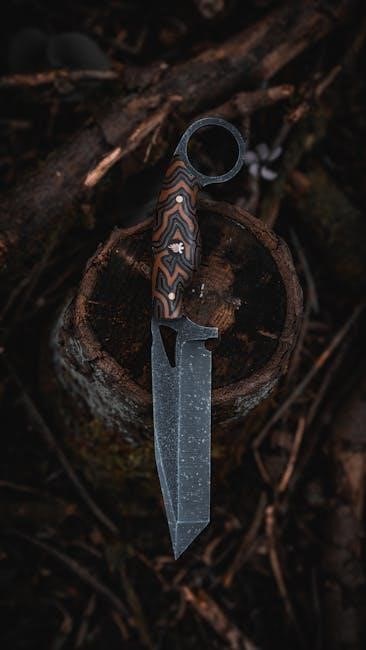
Creating Your Own Knife Steel Chart PDF
Designing a knife steel chart involves organizing data on steel types, properties, and comparisons. Use tools like Excel or graphic design software to structure the information clearly, ensuring it’s visually appealing and easy to understand. Include hardness, toughness, corrosion resistance, and edge retention details. Add charts or graphs to compare steels side by side. Once complete, save and print the chart as a PDF for quick reference or sharing. This guide becomes invaluable for knife enthusiasts and makers seeking to optimize their steel selection process effectively.
Designing a Comprehensive Guide
Creating a detailed knife steel chart PDF begins with organizing information systematically. Start by listing popular steel types, such as stainless, high-carbon, and specialty steels. Include key properties like hardness, toughness, corrosion resistance, and edge retention. Use clear headings and subheadings to separate sections, enhancing readability. Incorporate charts or tables to visually compare steels, making it easier for users to understand differences. Add brief descriptions for each steel type, highlighting their best uses. Use icons or color coding to differentiate categories, ensuring the guide is both informative and visually appealing. This structured approach ensures the PDF is a practical, go-to resource for knife enthusiasts and makers alike.
How to Use the Chart for Knife-Making
Using a knife steel chart for knife-making involves matching steel properties with the intended knife use. Start by identifying the knife’s purpose, such as cutting, slicing, or heavy-duty tasks. Refer to the chart to compare steels based on hardness, toughness, and corrosion resistance. Select a steel that aligns with your needs, ensuring it meets edge retention and durability requirements. Consider sharpening ease if the knife will be used frequently. For custom projects, cross-reference steel types with heat treatment recommendations to optimize performance. This methodical approach ensures the final product meets functional and aesthetic expectations, making the chart an indispensable tool for craftsmen and enthusiasts.
Downloading and Printing the PDF
Downloading and printing a knife steel chart PDF is a straightforward process. Start by locating a reliable source offering a comprehensive chart in PDF format. Ensure the file is high-resolution for clarity. Once downloaded, open the PDF using a compatible viewer like Adobe Acrobat. Adjust print settings to match your paper size and orientation for optimal display. Use cardstock or glossy paper to enhance readability. Double-check the scaling options to avoid cropping essential data. After printing, consider laminating the chart for durability, especially if it will be used frequently. This physical copy serves as a quick reference guide for knife-making projects, ensuring steel properties are easily accessible.
A knife steel chart PDF is an invaluable tool for knife enthusiasts, providing clear comparisons and insights. Use it to make informed decisions for your next project.
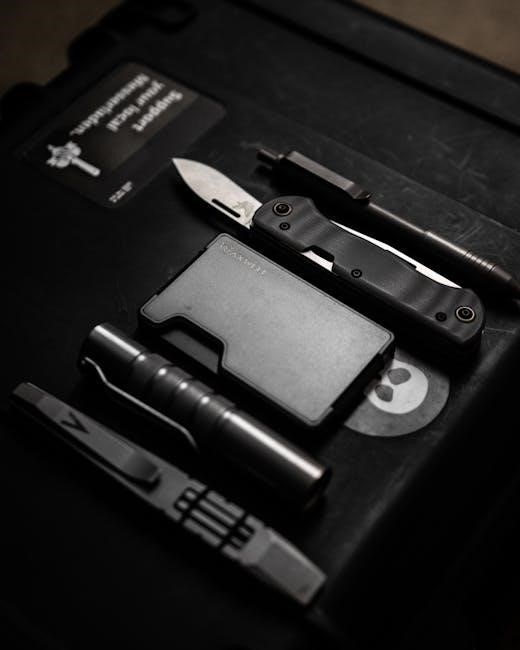
Final Thoughts on Knife Steel Selection
Selecting the right knife steel is a balance of hardness, toughness, corrosion resistance, and edge retention. A knife steel chart PDF simplifies this process by providing a visual guide to compare properties. Whether you’re crafting a kitchen knife, a tactical blade, or an EDC tool, understanding steel types ensures optimal performance. Remember, no single steel excels in all categories, so prioritize based on your needs. Experiment with different steels to gain firsthand experience, as practical use often reveals nuances not apparent in charts alone. With patience and knowledge, you’ll make informed decisions to create or choose the perfect knife for any task.
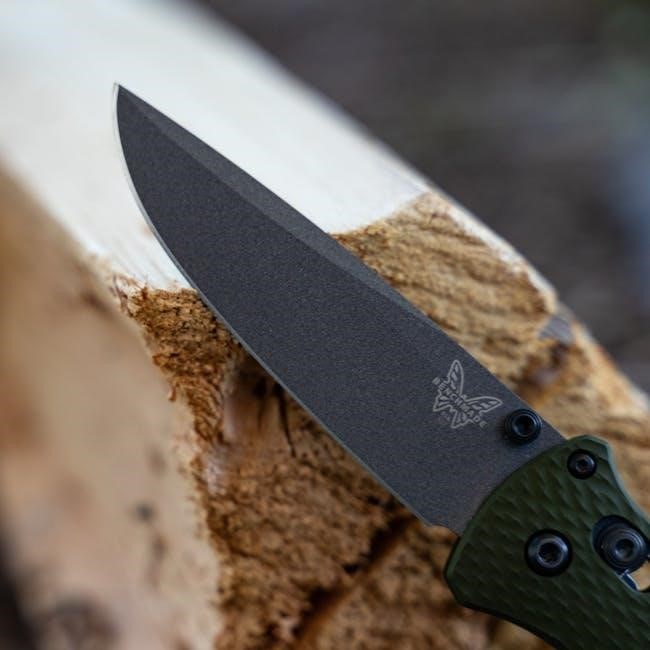
Encouragement to Explore and Experiment
Exploring and experimenting with knife steels is a rewarding journey that enhances your understanding of their properties and performance. A knife steel chart PDF serves as a valuable starting point, but hands-on experience is equally important. Try different steels, observe how they behave in various conditions, and learn from the results. Experimentation fosters innovation, whether you’re a knife-maker or an enthusiast. Don’t hesitate to test new materials or techniques—every trial brings valuable insights. Share your findings with others to contribute to the community’s knowledge. Remember, the world of knife steels is vast, and there’s always something new to discover. Embrace the process and enjoy the adventure of creating the perfect blade.
